Categories
New Blog
Tags
Choosing the correct size bike will result in a more comfortable and healthy ride. Experienced riders will tell you that all bikes feel and ride differently, even though their paper stats look pretty much the same.Manufacturers' listed mountain bike frame sizes can be confusing, and how you measure a bike frame is not set in stone. The traditional way is to list the seat tube length, but even that can vary as some measure to the top of the seat tube and some measure to the middle where the top tube joins the seat tube.
A lot of manufacturers just differentiate their bikes in XS, S, M, L, XL sizes, but quite a few manufacturers are starting to differentiate by reach numbers as well. That means they've been able to increase the reach, wheelbase and top tube length of the bike while trying to keep the seat tube length and stack height shorter and lower.
The smaller seat tube length means that shorter people can ride a bike with longer reach as they can adjust the seat height lower, potentially riding a larger bike. It's still important to consider seat tube and top tube length when shopping for a bike. The seat tube length will determine the lowest saddle height you can set, while the top tube length will roughly determine the amount of reach.
Well, finding the correct size frame like components on a bike, there is no one perfect solution because you can adjust the saddle, handlebars, etc. to help adjust your riding position. We recommend looking at the manufacturer's Xiamen Tour de Cycling Industry&Trade Co.,Ltd. size chart, which usually lists the recommended height range for each bike frame size they make:
Bicycle geometric size guide
13-14 inches
152-162 cm (5 feet -5 feet 4 inches)
above 185 cm (6 feet 1 inches above)
Bicycle size
Bicycle frame size
Rider height
XS
S
14-16 inches
162-170 cm (5 feet 4 inches - 5 feet 7 inches)
M
16-18 inches
170-178 cm (5 feet 7 inches - 5 feet 10 inches)
L
18-20 inches
178-185 cm (5 feet 10 inches - 6 feet 1 inch)
XL
20-22 inches
Most mountain bikes come in different shapes and sizes, so we recommend using the information below to help you understand what size mountain bike frame you should be riding.
First of all, it's good to know the structure of a mountain bike, as we'll be referring to these terms.
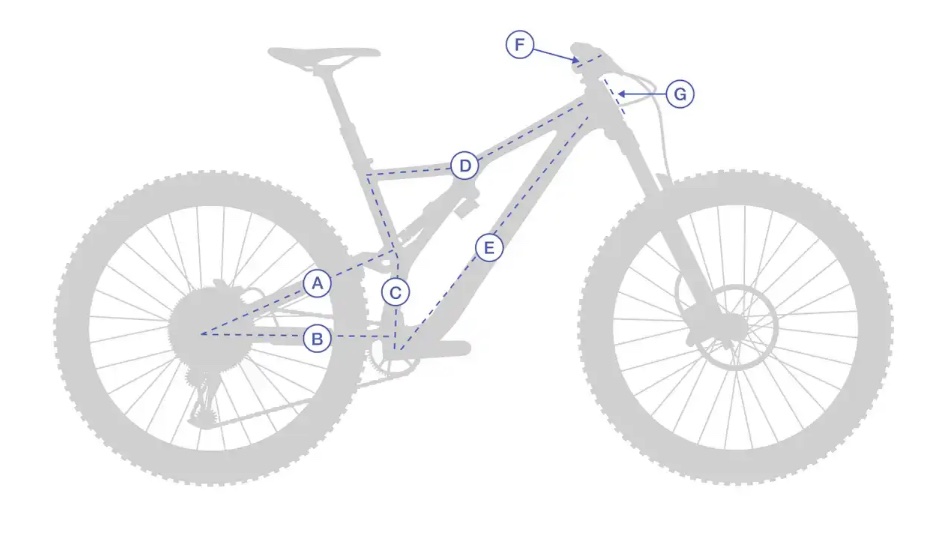
A. rear fork
B. Chainstay
C. Seat tube
D. Top tube
E. Down tube
F. Stem
G. Head tube
When considering your next bike purchase, it's crucial to understand how a bike's geometry will affect how it rides, and what each element of its geometry means. Knowing these terms will help you decide what size mountain bike you need.
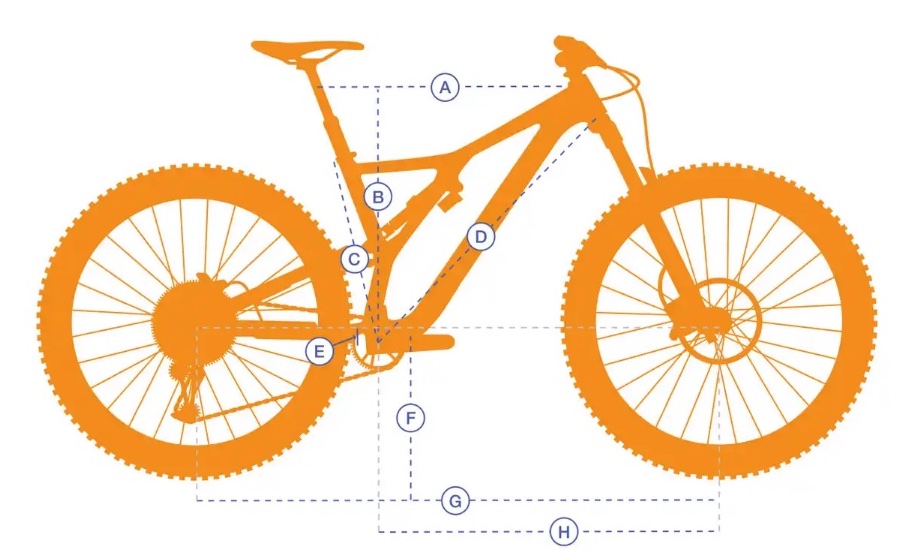
A. Top tube length is the length of an imaginary horizontal line drawn at the same height between the top of the bike's head tube and the center of the seatpost.
B. Stack height is the distance between the center of the bottom bracket and the center of the top of the head tube. This measurement determines the minimum height of the stem relative to the bottom bracket and is related to the bike's reach.
C. Seat tube length is the distance from the middle of the bottom bracket to the top of the top tube. This length determines how high or low the bike saddle can be set.
D. Down tube length is the distance between the center of the bottom of the head tube and the center of the bottom bracket. Down tube length data is not usually quoted on manufacturer's sizing charts, but it is an easy measurement for consumers when comparing two cars.
E. BB Drop means the distance that the center of the Axis is above or below the horizontal line connecting the Axis Centers.
F. BB height of the bottom bracket is the distance between the center of the central axis and the ground.
G. Wheelbase is the horizontal measurement between the centers of the front and rear axles.
H. Front center is the horizontal length between the center of the midshaft and the center of the front axle.
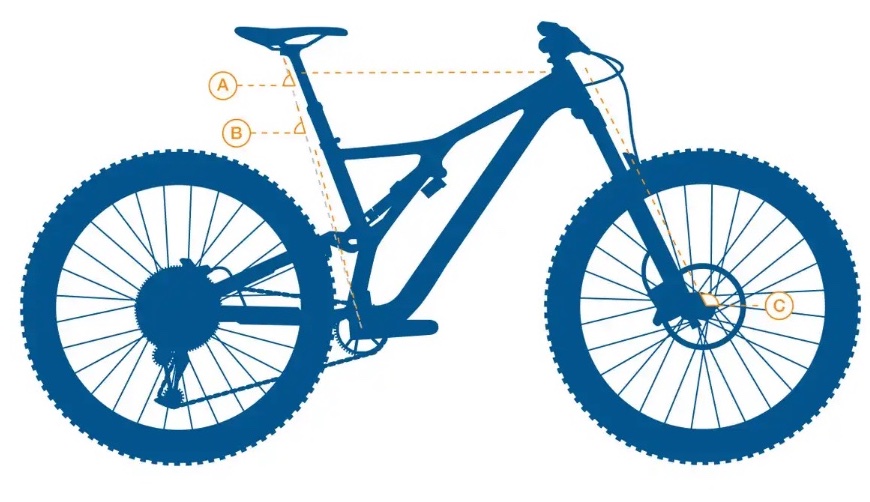
A. Effective seat tube angle is the angle of the line connecting the bottom bracket to the top center of the seat post when the bottom bracket is at pedaling height. Manufacturers often quote their effective seat tube angle, but usually don't disclose the measured height.
B. Actual seat tube angle is the angle of the bike's seatpost measured from horizontal.
C. Head tube angle is the angle of the fork steerer tube measured from horizontal.
Small details of bike setup often change the way you ride and the feel of your bike. When we sit on a bike, we touch three places: our hands on the handlebars, our feet on the pedals, and our butt on the saddle.
The relative positions of these three areas determine how the bike fits, and there are several variables that affect their exact placement: top tube length, seat tube angle, bottom bracket to saddle distance, crank length, stem height, and handlebar width all play a role.Adjust your ride settings from time to time, then give yourself some time to decide if it's right for you. When adjusting the position for the first time, some things will feel wrong, but after a few rides, you will get used to it.
Seat tube length
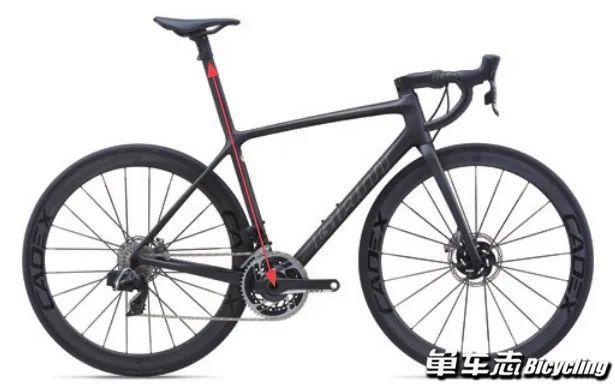
It's all about stance height, which is an important aspect of the fit of any bike because it controls crotch clearance. The seat tube should allow for acceptable stance clearance (the distance between the top tube and your crotch), to do this, stand as far back as possible on the bike and make sure there is at least an inch of space from the top tube to your crotch space.
While this applies to beginners and trail bikes, the rules change slightly depending on the shape of the frame, for example if it has a low top tube, or if one wants to buy a downhill or enduro bike they have Completely different geometry. Therefore, it's important not to use seat tube length and standover height as the only measure of a bike's fit.
Seat height and crank length
Most mountain bikes are available in 170mm or 175mm crank lengths, if you have short legs you may find the cranks too long to pedal, and too long legs with too short cranks can cause knee damage. For general off-road riding, the goal is to set the saddle height on the bike for maximum power and efficiency. Too high and your hips will rock side to side, wasting energy, too low and your muscles won't be able to effectively deliver power.
Top tube length
Top tube length determines physical comfort and efficiency on the bike. Off-road riders may prefer a long-reach stance, and beginners who have never off-roaded may wish to be more upright for extra comfort while putting less weight on their hands and wrists. Reach is usually a compromise between comfort, control and pedaling efficiency. Find what works best to avoid causing discomfort and back problems.
Mountain bike seat position
Typically horizontally set for an efficient off-road position, but some users prefer a slightly rearward saddle position for trick shows or steep downhill riding. Some people will prefer a slightly lower saddle front for a more forward riding position for climbing.
How far should the handlebars be from the seat ?
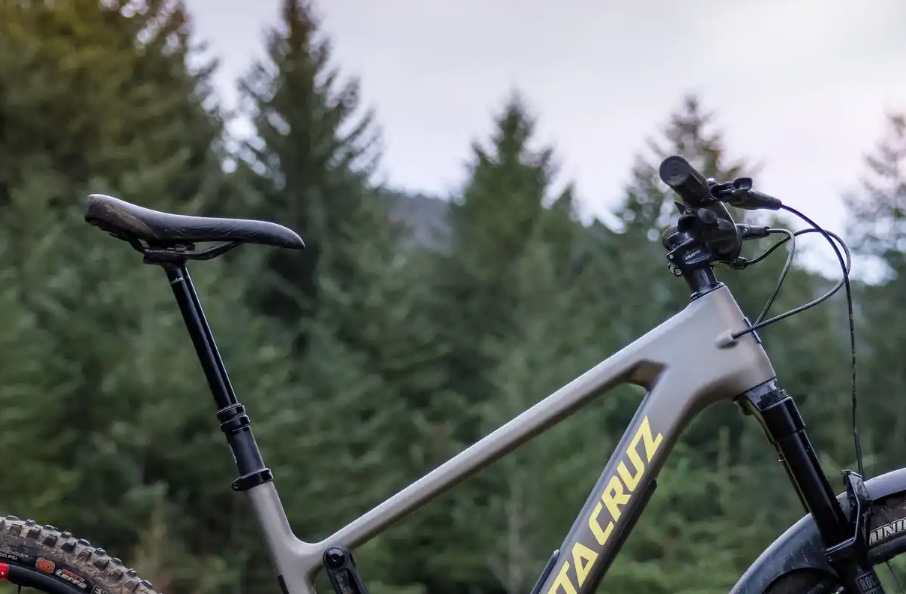
Arm, leg and torso lengths will vary for users of the same height, and weight distribution can have a significant impact on setup.
For an XC light trail bike, the starting point for determining the correct saddle to handlebar reach is to place the tip of your elbow on the nose of the saddle and see how far your longest finger extends along the bar, usually a full forearm length Good indicator of arm and torso length. Most users looking for a fast and efficient off-road riding position will find their longest finger stretches almost exactly halfway between the top of the steerer tube and the center of the handlebar.
Some handlebars have more generous sweeps that can be turned to adjust the grip position/wrist angle, some prefer straight bars, and some think 25 degree sweep is the ideal solution for them.
mountain bike handlebar height
Handlebar height depends on stack height, steerer tube length, number of spacers, and handlebar lift. Some riders prefer the higher position for more comfort, but competitive athletes typically lower it for a more aero position.
If you really don't know what size is right for you, your best bet is to go to your local bike shop for help. Some bike shops even offer professional bike fitting classes to find the right bike for each user.